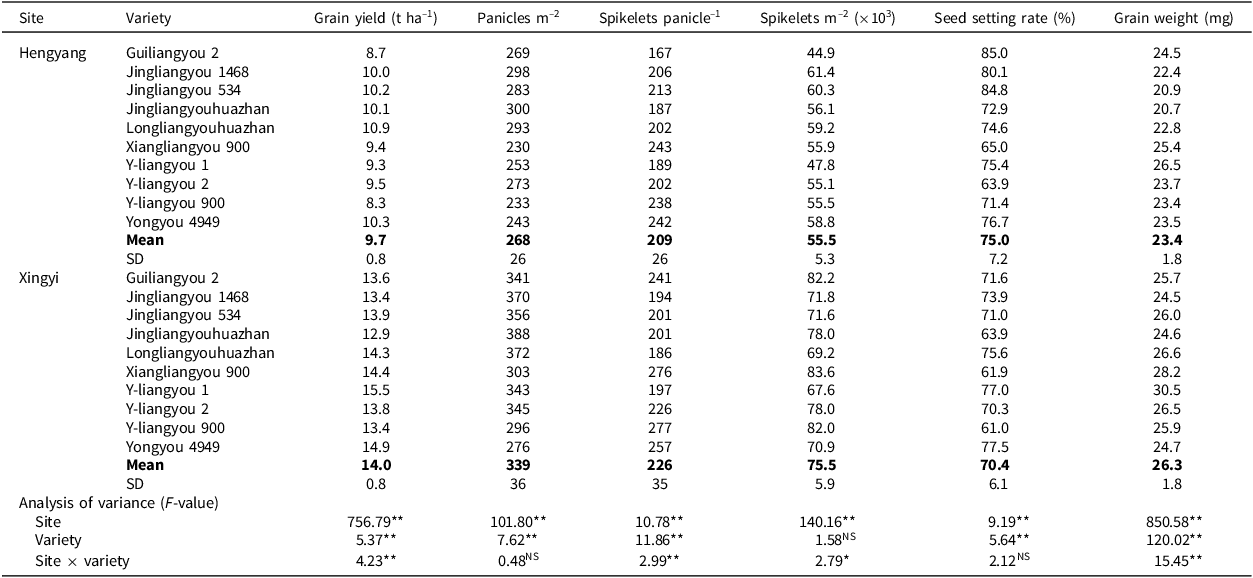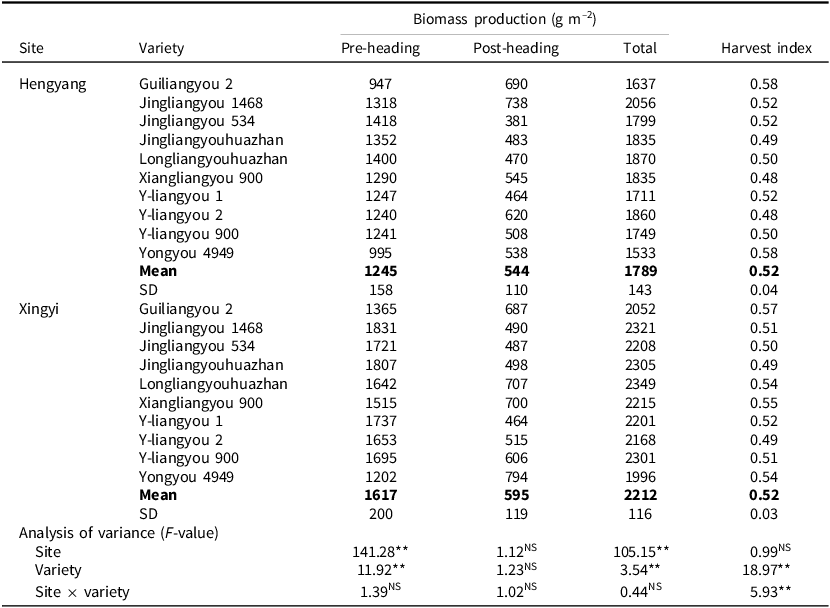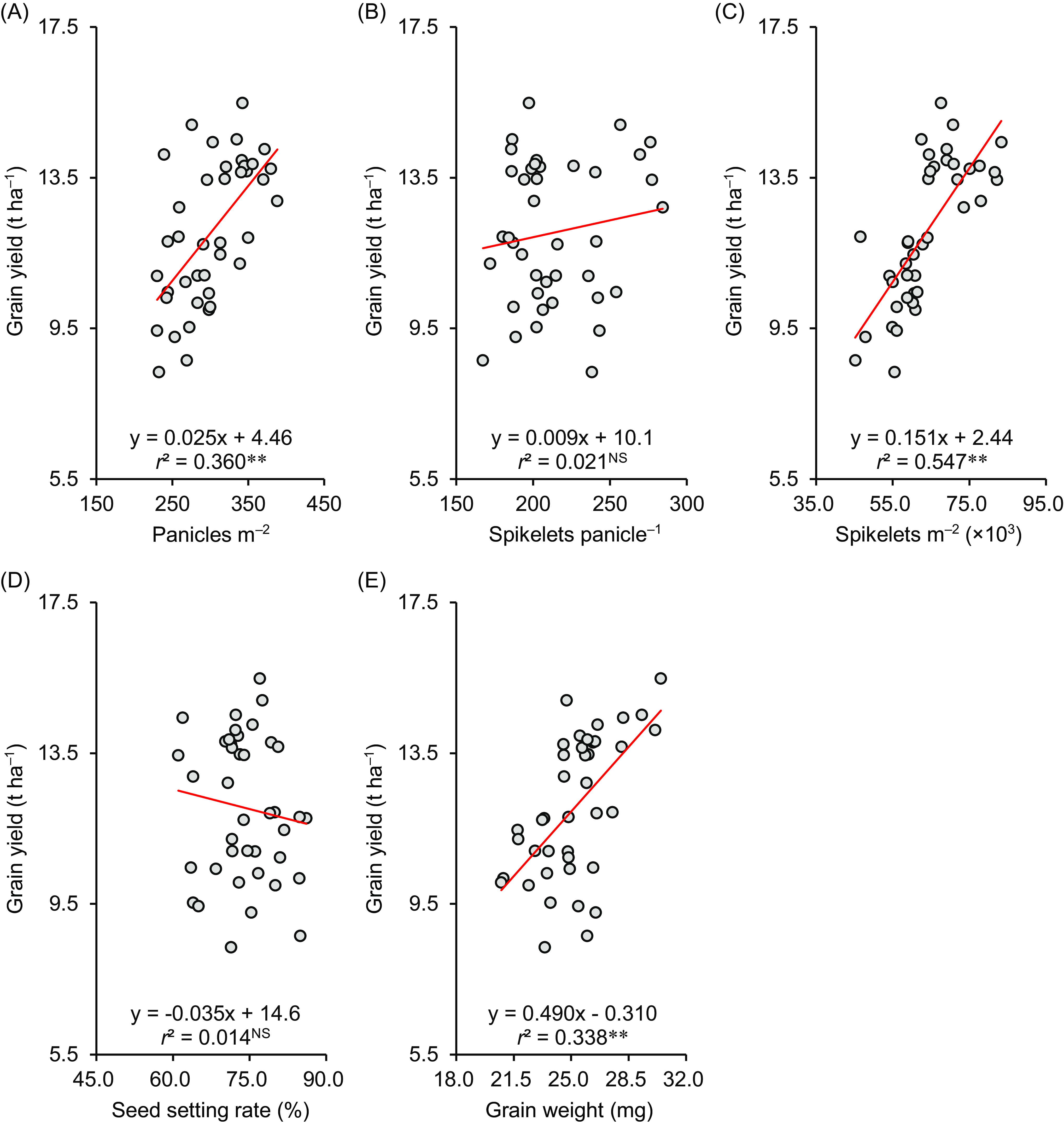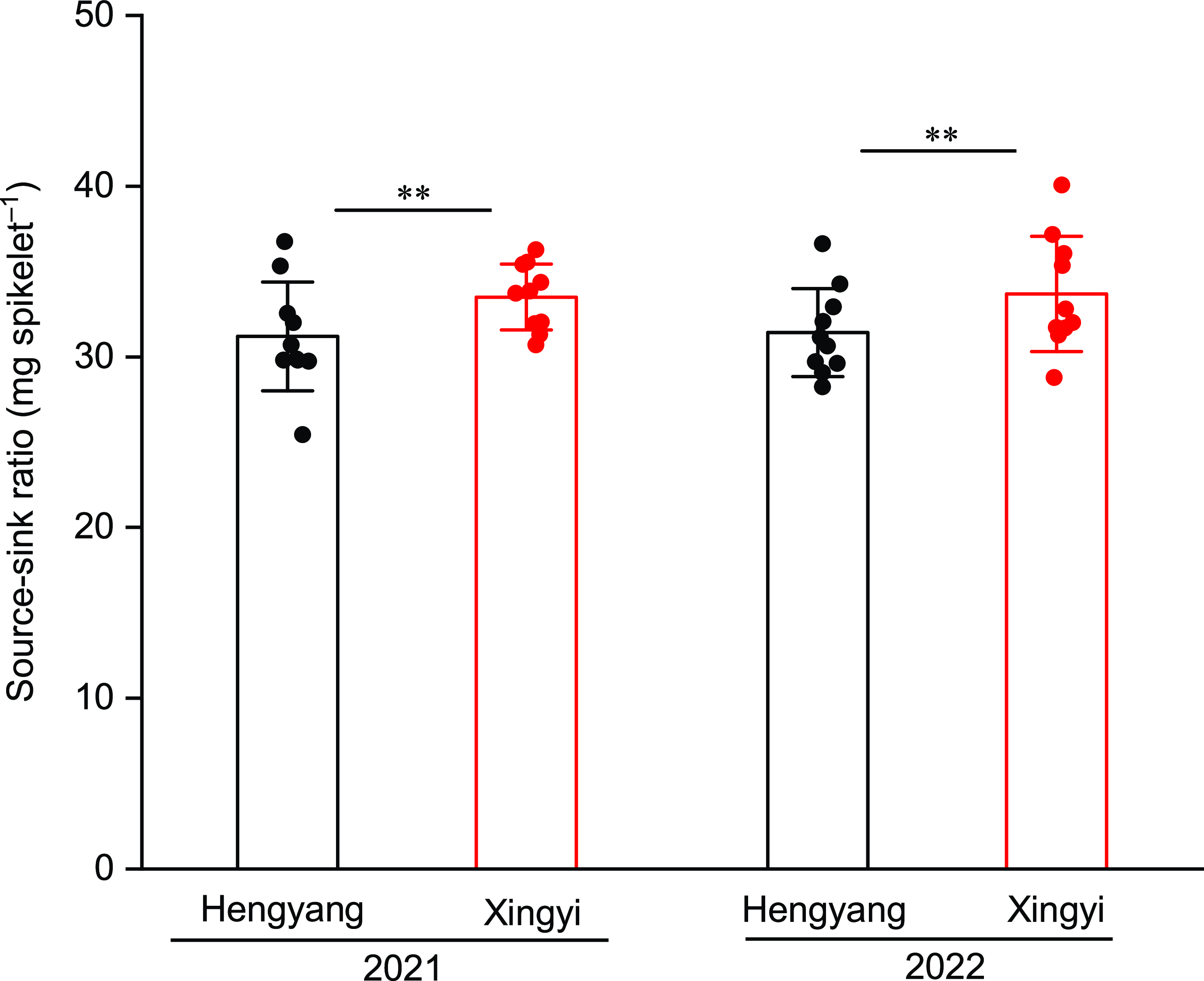Introduction
Rice is the staple food for more than half of the global population, providing more than 20% of the calories consumed worldwide (Fukagawa and Ziska, Reference Fukagawa and Ziska2019). China is the largest rice consumer globally, accounting for about 28% of global consumption (Yuan and Peng, Reference Yuan and Peng2022). To increase rice yield and ensure national food security, great efforts have been made in China to develop new rice varieties. Rice yield rose 30% due to the development of semi-dwarf varieties in the late 1950s to the early 1960s (Peng et al., Reference Peng, Tang and Zou2009). Through the development of hybrid varieties in the late 1970s, rice yield increased by an additional 10–20% (Peng et al., Reference Peng, Cassman, Virmani, Sheehy and Khush1999; Cheng et al., Reference Cheng, Cao, Zhuang, Chen, Zhan, Fan, Zhu and Min2007). By the 1990s to 2000s, the development of super hybrid varieties further increased rice yield by approximately 10% (Zhang et al., Reference Zhang, Tang, Zou, Li, Qin, Yang, Chen, Xia and Peng2009; Huang et al., Reference Huang, Zou, Jiang, Xia, Ibrahim and Ao2011a).
Rice yield is not only determined by the variety but also by the environment (Guo et al., Reference Guo, Xiang, Li, Ma and Du2021). Super high rice yield (> 12 t ha−1), including super hybrid rice varieties, is generally achieved at special eco-sites (i.e. super high-yielding sites) (Huang et al., Reference Huang, Jiang, Xia, Zou, Jiang and Ao2013a; Jiang et al., Reference Jiang, Xie, Huang, Zhou, Zhang, Chen, Wu, Xia, Xiong, Xu and Zou2016; Katsura et al., Reference Katsura, Maeda, Lubis, Horie, Cao and Shiraiwa2008; Li et al., Reference Li, Xue, Gu, Yang, Wang, Ling, Qin and Ding2009; Ying et al., Reference Ying, Peng, He, Yang, Yang, Visperas and Cassman1998). An understanding of yield attributes of rice crops grown at super high-yielding sites would provide useful information to identify feasible approaches for achieving super high yield in rice.
Rice yield is determined by four components: panicles per m2, spikelets per panicle, seed setting rate, and grain weight (Xiong et al., Reference Xiong, Flexas, Huang, Cui, Wang, Douthe and Lin2022). However, there is no consistent conclusion about the key yield components for super high rice yield, and different studies have highlighted different components or combinations of components as being responsible. For example, Ying et al. (Reference Ying, Peng, He, Yang, Yang, Visperas and Cassman1998), Katsura et al. (Reference Katsura, Maeda, Lubis, Horie, Cao and Shiraiwa2008), and Huang et al. (2013) reported that high panicles per m2 and spikelets per panicle were responsible for the super high yield in rice. Li et al. (Reference Li, Xue, Gu, Yang, Wang, Ling, Qin and Ding2009) reported that high panicles per m2, seed setting rate, and grain weight were responsible for the super high yield in rice.
Rice yield can also be expressed as a function of total biomass production and harvest index (Huang et al., Reference Huang, Yin, Jiang, Zou and Deng2015). Although previous studies have documented that super high rice yield is attributable to high total biomass production rather than high harvest index (Huang et al., Reference Huang, Jiang, Xia, Zou, Jiang and Ao2013a; Katsura et al., Reference Katsura, Maeda, Lubis, Horie, Cao and Shiraiwa2008; Li et al., Reference Li, Xue, Gu, Yang, Wang, Ling, Qin and Ding2009; Ying et al., Reference Ying, Peng, He, Yang, Yang, Visperas and Cassman1998), the results of these studies concerning the characteristics of biomass production in super high-yielding rice crops are inconsistent. Ying et al. (Reference Ying, Peng, He, Yang, Yang, Visperas and Cassman1998) reported that super high-yielding rice crops had high biomass production capacity during the vegetative and grain-filling periods, whereas Katsura et al. (Reference Katsura, Maeda, Lubis, Horie, Cao and Shiraiwa2008) reported that high biomass production capacity was observed during the grain-filling period but not during the vegetative period in super high-yielding rice crops.
In this study, we compared grain yield and yield attributes of ten high-yielding hybrid rice varieties between a super high-yielding site and a site with typical yields. The objectives of this study were to (1) clarify the key yield attributes responsible for the super high yield in rice and (2) potentially identify how to achieve super high yield in rice.
Materials and methods
Soils and climate
Field experiments were conducted at Xingyi (25°01′14′′ N, 104°55′45′′ E, 1165 m a.s.l.), Guizhou Province, and Hengyang (26°52′31′′ N, 112°30′07′′ E, 73 m a.s.l.), Hunan Province, China in 2021 and 2022. For rice production, Xingyi is a super high-yielding site, while Hengyang has typical yields. Soil chemical properties in the upper 20 cm layer of the experimental fields before transplanting in 2021 and climatic conditions (average daily mean temperature and total incident solar radiation) during the rice-growing season (from sowing to harvesting) in 2021 and 2022 are given in Table 1.
Table 1. Soil chemical properties of the experimental fields before transplanting in 2021 and climatic conditions during the rice-growing season in 2021 and 2022 at two sites (Hengyang and Xingyi)

Experimental design and crop management
Ten high-yielding hybrid rice varieties (Guiliangyou 2, Jingliangyou 1468, Jingliangyou 534, Jingliangyouhuazhan, Longliangyouhuazhan, Xiangliangyou 900, Y-liangyou 1, Y-liangyou 2, Y-liangyou 900, and Yongyou 4949) were used in this study. Six of the ten varieties (Guiliangyou 2, Jingliangyouhuazhan, Longliangyouhuazhan, Y-liangyou 1, Y-liangyou 2, and Y-liangyou 900) are super hybrid rice varieties approved by the Ministry of Agriculture and Rural Affairs of China. The varieties were arranged in a randomised complete-block design with three replicates. The plot size was 15 m2 at Xingyi and 20 m2 at Hengyang.
Pre-germinated seeds were sown on a seedbed to raise seedlings. Two seedlings per hill were transplanted at a hill spacing of 20 cm × 20 cm. Basal fertiliser (90 kg N ha−1, 90 kg P2O5 ha−1, and 90 kg K2O ha−1) was applied 1 day before transplanting. The first top dressing (36 kg N ha−1) was applied 7 days after transplanting. The second top dressing (54 kg N ha−1 and 90 kg K2O ha−1) was applied at the panicle initiation stage. Continuous flooding (5–10 cm water depth) was practised in all plots from transplanting until one week before maturity, when the plots were drained for harvesting. Plant diseases, insects, and weeds were intensively controlled by pesticides.
Sampling and measurements
Ten hills of rice plants were sampled from each plot at heading and maturity stages. The plants sampled at the heading stage were separated into stems, leaves, and panicles. Each organ was oven-dried at 70 °C to a constant weight to determine biomass. Plants sampled at maturity were hand threshed after counting panicle number. Filled and unfilled spikelets were separated by submerging them in tap water. Three subsamples of 30 g of filled spikelets and all unfilled spikelets were used to count spikelet numbers. The number of filled spikelets was counted with a digital automatic seed counter (SLY-C, Zhejiang Top Cloud-Agri Technology Co., Ltd., Hangzhou, China). The number of unfilled spikelets was counted manually. All plant organs were oven-dried at 70 °C to a constant weight to determine biomass. Yield components (panicles per m2, spikelets per panicle, spikelets per m2, seed setting rate, and grain weight), pre-heading biomass production (biomass production per m2 at the heading stage), total biomass production (biomass production per m2 at the maturity stage), post-heading biomass production (total biomass production – pre-heading biomass production), harvest index (filled grain biomass/total biomass production), source-sink ratio (total biomass production/spikelets per m2), pre-heading crop growth rate (pre-heading biomass production/pre-heading growth duration), and post-heading crop growth rate (post-heading biomass production/post-heading growth duration) were calculated.
Rice plants were harvested from a 5 m2 area in each plot to determine grain yield. Harvested grains were weighed after sun-drying. A subsample of 50 g of sun-dried grains was oven-dried at 70 °C to a constant weight to determine moisture content. Grain yield was calculated by adjusting to a moisture content of 14%.
Statistical analysis
All data were analysed separately for each year, using analysis of variance (Statistix 8.0, Analytical Software, Tallahassee, FL, USA). Linear regression analysis was employed to evaluate the relationships between grain yield and yield attributes (panicles per m2, spikelets per panicle, spikelets per m2, seed setting rate, grain weight, total biomass production, and harvest index) across ten hybrid rice varieties grown at two sites in 2 years.
Results
Because (1) the focus of this study was to compare grain yield and yield attributes between two sites and (2) the interactive effect of site and variety was either not significant or not consistent across 2 years for grain yield and most yield attributes (Tables 2–5), the following subsections primarily describe the main effects of site on grain yield and yield attributes.
Table 2. Grain yield and yield components of ten hybrid rice varieties grown at two sites in 2021

* and ** denote significance at p < 0.05 and p < 0.01, respectively. NS denotes non-significance at p < 0.05.
Table 3. Grain yield and yield components of ten hybrid rice varieties grown at two sites in 2022

* and ** denote significance at p < 0.05 and p < 0.01, respectively. NS denotes non-significance at p < 0.05.
Table 4. Biomass production and harvest index of ten hybrid rice varieties grown at two sites in 2021

** and NS denote significance at p < 0.01 and non-significance at p < 0.05, respectively.
Table 5. Biomass production and harvest index of ten hybrid rice varieties grown at two sites in 2022

** and NS denote significance at p < 0.01 and non-significance at p < 0.05, respectively.
Grain yield and yield components
Grain yield significantly differed with site in both 2021 and 2022 (Tables 2 and 3). Grain yield at Xingyi ranged from 11.8 to 14.5 t ha−1 in 2021 and from 12.9 to 15.5 t ha−1 in 2022, showing respective averages of 13.4 and 14.0 t ha−1. The average grain yield was 20% and 44% higher at Xingyi than at Hengyang in 2021 and 2022, respectively.
Panicles per m2, spikelets per m2, and grain weight were significantly different between sites in both 2021 and 2022, while the differences in spikelets per panicle and seed setting rate between sites were not significant in either 2021 or 2022 (Tables 2 and 3). Average panicles per m2, spikelets per m2, and grain weight were, respectively, higher at Xingyi than at Hengyang by 11%, 14%, and 10% in 2021 and by 26%, 36%, and 12% in 2022. Linear regression analysis showed that grain yield was significantly positively related to panicles per m2, spikelets per m2, and grain weight (Figure 1A, C, and E) but was not significantly related to spikelets per panicle and seed setting rate (Figure 1B and 1D).

Figure 1. Relationships between grain yield and yield components in ten hybrid rice varieties grown at two sites (Hengyang and Xingyi) in 2 years (2021 and 2022). ** denotes a significant relationship at p < 0.01. NS denotes a non-significant relationship at p > 0.05.
Biomass production and harvest index
Pre-heading biomass production and total biomass production were significantly different between sites in both 2021 and 2022, whereas the difference in post-heading biomass production was only significant in 2022 (Tables 4 and 5). Xingyi had higher average pre-heading biomass production and total biomass production than Hengyang by 30% and 24% in 2021 and by 40% and 45% in 2022, respectively. There was no significant difference in harvest index between sites in either 2021 or 2022. Linear regression analysis showed that grain yield was significantly positively related to total biomass production (Figure 2A) but was not significantly related to harvest index (Figure 2B).

Figure 2. Relationships of grain yield to total biomass production (A) and harvest index (B) in ten hybrid rice varieties grown at two sites (Hengyang and Xingyi) in 2 years (2021 and 2022). ** denotes a significant relationship at p < 0.01. NS denotes a non-significant relationship at p > 0.05.
Source-sink ratio, crop growth duration, and crop growth rate
The difference in source-sink ratio between sites was significant in both 2021 and 2022 (Figure 3). The average source-sink ratio was 7% higher at Xingyi than at Hengyang in both 2021 and 2022. Pre-heading and post-heading growth durations were significantly different between sites in both 2021 and 2022 (Figure 4A and 4B). Average pre-heading growth duration was longer at Xingyi compared to Hengyang by 18 days in 2021 and by 17 days in 2022. The average post-heading growth duration was 3 days shorter and 12 days longer at Xingyi than at Hengyang in 2021 and 2022, respectively. Pre-heading crop growth rate significantly differed between sites in both 2021 and 2022, whereas the difference in post-heading crop growth rate between sites was only significant in 2022 (Figure 4C and 4D). The average pre-heading crop growth rate was higher at Xingyi compared to Hengyang by 9% in 2021 and by 20% in 2022.

Figure 3. Source-sink ratios of ten hybrid rice varieties grown at two sites (Hengyang and Xingyi) in 2 years (2021 and 2022). Columns and error bars are mean ± SD of ten varieties. Each circle represents the mean of three replicates of a variety. ** denotes a significant difference between the two sites at p < 0.01.

Figure 4. Crop growth durations (A and B) and crop growth rates (C and D) during the pre-heading period (A and C) and the post-heading period (B and D) of ten hybrid rice varieties grown at two sites (Hengyang and Xingyi) in 2 years (2021 and 2022). Columns and error bars are mean ± SD of ten varieties. Each circle represents the mean of three replicates of a variety. * and ** denote significant differences between sites at p < 0.05 and p < 0.01, respectively. NS denotes a non-significant difference between sites at p < 0.05.
Discussion
In this study, rice crops produced an average grain yield of nearly 14.0 t ha−1 at Xingyi. This yield level is comparable to that reported at this site by Jiang et al. (Reference Jiang, Xie, Huang, Zhou, Zhang, Chen, Wu, Xia, Xiong, Xu and Zou2016), who showed that two super hybrid rice varieties produced an average grain yield of 13.5 t ha−1 across 2 years at Xingyi under fertilised conditions. The highest grain yield at Xingyi in this study was 15.5 t ha−1, which is slightly higher than the lower boundary of the previously reported highest grain yields (15.2–18.5 t ha−1) in Taoyuan, Yunnan Province, China (Katsura et al., Reference Katsura, Maeda, Lubis, Horie, Cao and Shiraiwa2008; Li et al., Reference Li, Xue, Gu, Yang, Wang, Ling, Qin and Ding2009; Ying et al., Reference Ying, Peng, He, Yang, Yang, Visperas and Cassman1998), a well-known site where the highest rice yield in the world has been recorded (Zhong et al., Reference Zhong, Hu, Xia, Zhang, Li, Pan, Zhao, Wang, Yan, Shangguan, Hu, Yang and Wang2020). These findings support that Xingyi is a typical super high-yielding site for rice production.
Xingyi produced more than 30% higher average grain yield of rice than Hengyang. From the point of view of ecological characteristics, both higher soil fertility and better climatic conditions during the rice-growing season (lower daily mean temperature and higher total incident solar radiation) were responsible for the higher grain yield of rice at Xingyi than at Hengyang (Table 1). From the point of view of yield components, the yield advantage at Xingyi compared to Hengyang was related to both higher panicles per m2 and higher grain weight. This finding is not in agreement with that reported in previous studies (Huang et al., Reference Huang, Jiang, Xia, Zou, Jiang and Ao2013a; Katsura et al., Reference Katsura, Maeda, Lubis, Horie, Cao and Shiraiwa2008; Li et al., Reference Li, Xue, Gu, Yang, Wang, Ling, Qin and Ding2009; Ying et al., Reference Ying, Peng, He, Yang, Yang, Visperas and Cassman1998), which showed that the difference in grain yield between super high-yielding sites and those with typical yields was attributable to the differences in panicles per m2 and spikelets per panicle or the differences in panicles per m2, seed setting rate, and grain weight. These results demonstrate that there are multiple approaches to achieving super high rice yield, and this study suggests a new one, that is, simultaneously increasing panicles per m2 and grain weight.
Panicle number is closely associated with the number of tillers, which is regulated by carbohydrate supply (Huang et al., Reference Huang, Zou, Jiang, Xia, Feng, Cheng and Mo2011b). In this study, the higher panicles per m2 at Xingyi compared to Hengyang could be partially explained by higher pre-heading biomass production. In addition, previous studies have shown strong compensation between panicles per m2 and spikelets per panicle in rice crops (Ying et al., Reference Ying, Peng, He, Yang, Yang, Visperas and Cassman1998; Huang et al., Reference Huang, Jiang, Xia, Zou, Jiang and Ao2013a). However, in this study, the higher panicles per m2 at Xingyi did not lead to lower spikelets per panicle than at Hengyang, indicating reduced compensation between the two components at Xingyi. In general, decoupling the compensatory relationship between panicles per m2 and spikelets per panicle can be accomplished by increasing biomass production during panicle formation (Huang et al., Reference Huang, Jiang, Xia, Zou, Jiang and Ao2013a). This might be also responsible for the reduced compensation between the two components at Xingyi in this study, where pre-heading biomass production was higher at Xingyi than at Hengyang.
Grain weight is determined by source capacity (biomass production) and the allocation of biomass to grains (Ntanos and Koutroubas, Reference Ntanos and Koutroubas2002). In this study, because there was no significant difference in harvest index between Xingyi and Hengyang, the higher grain weight at Xingyi should be attributable to greater source capacity compared to Hengyang. This was supported by a higher source-sink ratio at Xingyi than at Hengyang. The source-sink ratio is the ratio of total biomass production to spikelets per m2, and a higher source-sink ratio can be achieved by increasing total biomass production or/and decreasing spikelets per m2. In this study, the higher source-sink ratio at Xingyi was attributable to higher total biomass production because Xingyi had higher spikelets per m2 than Hengyang.
Total biomass production can be increased by increasing pre-heading and/or post-heading biomass production. In this study, the higher total biomass production at Xingyi compared to Hengyang was mainly attributable to higher pre-heading biomass production because there was no consistent difference in post-heading biomass production between the two sites across 2 years. This finding is not in agreement with that reported in previous studies (Katsura et al., Reference Katsura, Maeda, Lubis, Horie, Cao and Shiraiwa2008; Ying et al., Reference Ying, Peng, He, Yang, Yang, Visperas and Cassman1998), which showed that super high-yielding sites had higher post-heading production than sites with typical yields.
Biomass production is a function of growth duration and crop growth rate (Zheng et al., Reference Zheng, Wang, Yang, Xiao, Sun, Huang, Peng and Wang2022). In this study, both longer pre-heading growth duration and higher pre-heading crop growth rate were responsible for the higher pre-heading biomass production at Xingyi compared to Hengyang. Crop growth duration is closely associated with temperature, with a lower temperature leading to a longer duration (Huang et al., Reference Huang, Zhang, Jiang and Zou2013b). This is also why pre-heading growth duration was longer at Xingyi than at Hengyang in this study. A high crop growth rate can be achieved by increasing photosynthetic capacity and/or decreasing respiration rate (Yamori, Reference Yamori, Kozai, Niu and Takagaki2020). In this study, the leaf biomass at heading was 6% and 31% higher at Xingyi than at Hengyang in 2021 and 2022, respectively (data not shown), indicating that rice plants grown at Xingyi might have higher leaf area index and hence higher photosynthetic capacity than those grown at Hengyang. In addition, rice plants at Xingyi might have a lower respiration rate than those at Hengyang because a lower temperature leads to a lower respiration rate (Li et al., Reference Li, Chen, Feng, Peng, Tao and Fu2021). These results highlight the need for further investigations to determine the characteristics of photosynthesis and respiration in rice crops grown at super high-yielding sites.
Conclusions
Ten high-yielding hybrid rice varieties produced an average grain yield of nearly 14.0 t ha−1 at Xingyi (a super high-yielding site), which was more than 30% higher than that at Hengyang (a site with typical yields). The higher grain yield at Xingyi than at Hengyang was attributable to higher panicles per m2 and higher grain weight. Greater source capacity resulting from improved pre-heading biomass production was responsible for the higher panicles per m2 and the higher grain weight at Xingyi than at Hengyang. This study suggests a potential strategy for achieving super high yield in rice – namely, that super high yield in rice can be achieved in rice by simultaneously increasing panicle number and grain weight via improving pre-heading biomass production.
Acknowledgements
The authors thank other members of the Rice and Product Ecophysiology for their help with this study.
Funding statement
This work was supported by the Earmarked Fund for China Agriculture Research System (CARS-01).
Competing interests
The authors declare none.












